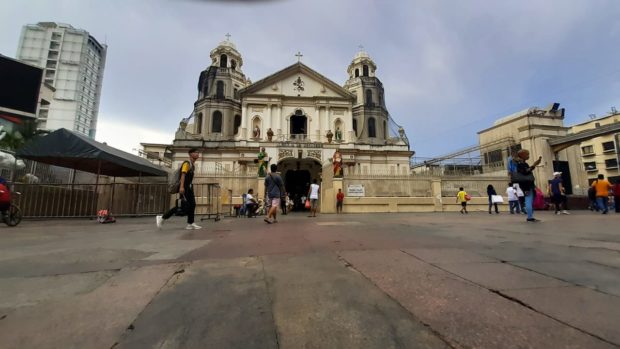
A clear view of the Quiapo Church through Plaza Miranda. (File photo by ED LUSTAN / INQUIRER.net)
MANILA, Philippines — Manila Archbishop Jose Cardinal Advincula has formally elevated the Quiapo Church, which houses the widely revered Black Nazarene icon, as an archdiocesan shrine, recognizing the church as a pilgrimage site.
“We hereby decree that the Minor Basilica of the Black Nazarene — St. John the Baptist Parish (Quiapo Church) — be conferred the title of the Archdiocesan Shrine of the Black Nazarene,” Advincula said in a decree of erection dated May 10.
The cardinal granted to the newly decreed Archdiocesan Shrine of the Black Nazarene “all the rights and privileges” of its status based on the provisions of Canons 1230 to 1234 on shrines in the Code of Canon Law of the Catholic Church.
“By the term shrine is understood to be a church or other sacred place to which numerous members of the faithful make pilgrimage for a special reason of piety, with the approval of the local ordinary,” Canon 1230 states.
“For a shrine to be called a national shrine, the conference of bishops must give its approval; for it to be called an international shrine, the approval of the Holy See is required,” states Canon 1232.
The episcopal decree approved the petition of the church’s rector, Fr. Rufino Sescon Jr., who earlier announced plans to petition for the elevation of Quiapo Church’s status as a national shrine.
Quiapo Church’s new status was announced by the priests who presided over the Mass on Wednesday.
The Archdiocese of Manila’s vicar general, Fr. Reginald Malicdem, said Quiapo Church’s recognition as an archdiocesan shrine was “long overdue.”
A wooden church was first put up shortly after the arrival of Spanish priests in 1572, even before the Black Nazarene was brought to the country from Mexico, and was rebuilt several times after it was destroyed by fire or earthquake over the next four centuries.
Only on Dec. 11, 1987, was the church recognized by Pope John Paul II as a minor basilica with some ecclesiastical privileges, citing its role in “strengthening a deep popular devotion to Jesus Christ and its cultural contribution to the religiosity of the Filipino people.”
“But for us devotees, whether there is a formal declaration or none is made, this church is a real shrine because here we feel the presence of God,” Malicdem said in his homily.
“In this place, we experience the mercy, compassion, peace, and love of God for us,” he added.
READ:
Quiapo Church visitors reach almost 188,000 from Maundy Thursday until Easter
Quiapo Church: Around 20,000 devotees join Black Nazarene procession on Good Friday